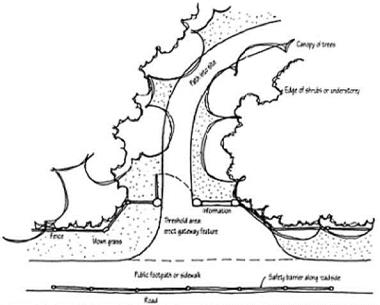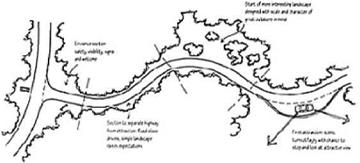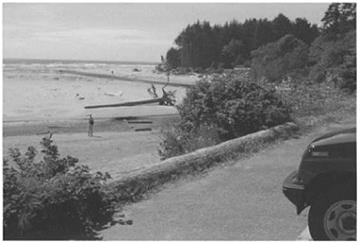The culmination of the journey—the arrival at the main destination—is now at hand. After all the careful development of the landscape and provision of information along the way, the first experience on arrival must live up to its promise. How this is handled depends on what is there. If it is a natural wonder such as a mountain range the visitor should be rewarded with a stunning view to a dramatic peak, unobscured by parked cars or other clutter. This technique can be used widely: for example, for a lake, canyon, grove of giant trees or sand dunes and cliffs.
A less dramatic destination should make the most of the features it possesses, perhaps even a building containing a visitor centre if one is present. The management of the setting can help, creating or enhancing a sense of genius loci, by reducing the impact of car parking, reflecting the qualities of the place in the use of materials and so on. It is at the point of arrival that the genius loci is at most risk, especially in places with subtle qualities. For this reason it is important to the subsequent design to consider the factors
|
A pedestrian entrance from a public road should present an attractive, untbreatening appearance. Information and safety near the road should be considered, while the visibility and attractiveness of the area should be maintained. Litter and vandalism may discourage some visitors who are anxious for their safety in wilder places. |
![]()
|
|
The wind-down stretch of road helps the visitors to develop a more relaxed frame of mind, ready to make the most of their experience.
|
|
At this recreation area at the Pacific Rim National Park, Vancouver Island,
Canada, the sense of arrival is given by the view of the shore, the waves of the Pacific Ocean and the backdrop offorest.
Unfortunately, the impression is spoilt by the cars parked along the edge, which screen much of the view.
that contribute to genius loci, and to develop a concept for the site development around them.
The visitors should also obtain some impression of the organization of the site on arrival. Not everything there will be visible, but a reasonable degree of orientation is advisable. This can be achieved by, for example, a glimpse of the main attraction, the visitor centre or a picnic area, before the last stretch of access road turns into the car park.
This is an old but effective device, which subtly reinforces the expectation just before arrival.
The general layout of the site should then be organized around the axes between the point of arrival and the main attraction, if there is one. The movement of people and their associated activities, from car parking and toilet facilities to picnicking, playing, hiking or whatever, needs to flow in an easy and obvious fashion. This is particularly important in heavily used sites with a large throughput of people. Congestion caused by confusion slows down the movement of people and reduces the carrying capacity of busy sites.






